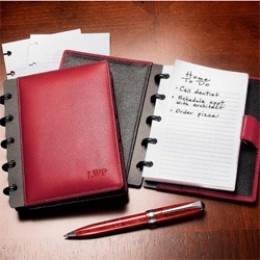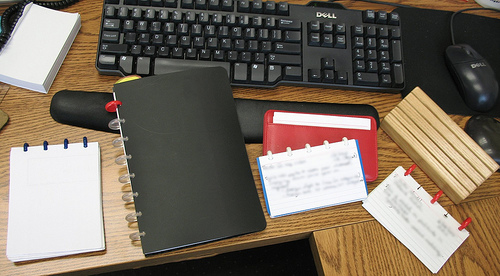DIY Daily Planners

Create a Custom Personal Organizer
Are you tired of paying high prices to refill your Day Planner? Do the available selections at the office supply store not fulfill your specific needs? If you're looking to improve your current time management system or are just beginning to put together a personal organizer then consider making your own. With only a few common tools (paper, computer, printer, hole punch, paper trimmer) you can create a planner for work, home or family that suits your exact needs. A custom organizer can make time management more efficient, not to mention aesthetically pleasing.
Which Planner Size?
- Classic size, which is 5.5"x8.5", half the size of a regular letter-size sheet of paper as found in North America and some South American countries. A planner this size offers a great balance of writing space, portability, and amount of material to carry. You can generally find decent Mead or At-A-Glance planners this size at your local department story for $7-$20 USD, or you can buy upscale Day Runner or Day-Timer products for $40 USD and up at your office supply store.
- A5 size, which is half an A4 sheet, and found in most other countries world-wide outside of North America. These planners are a little bit wider and not quite as tall as classic, but otherwise are very similar. Filofax is a popular brand with a wide range of options.
- Letter size, which is standard North American full-size sheets (8.5"x11"). Great if you need a lot of space, but poor for portability; it can get large and heavy. Planners and binders this size can be found quite cheaply indeed.
- A4 size, the rough equivalent of letter size in most countries outside of North America, and subject to many of the same pros and cons of letter size above.
- Hipster PDA size, which is 3"x5" index card size (people outside North America often scale to slightly different sizes). Many people keep a stack of index cards with to-do lists, calendars, notes and other important info. Small and portable, and all you really need is a binder clip to keep it together. However, they are also difficult to file, you cannot carry around too many without facing organisational issues (think of shuffling a pack of cards), and printing/cutting them can be a pain if your printer isn't in complete agreement with your choice of planner.
Choosing the Binding System - Binding systems can be made from basic items around the office or purchased from a specialty store.

photo credit: mpclemens
- Clip - A backover clip is pretty useful with the Hipster PDA pocket sized planner, especially if you like to reorganize your cards regularly.
- Ring - You can use one single ring to hold your pocket sized planner together, or you can purchase a binder or cover in any configuration from 3 to 7 rings for any other size. These are easy to find in any office supply store, as well as the hole punches to go along with them.
- Disc - Disc-binding is a variation of notebook binding that allow pages to be added, removed, and replaced easily. Additionally pages can be transferred between notebooks of different functions and sizes.
A page perforated for a disc-bound binding system contains a row of teeth along the side edge of the page that grip onto the outside raised perimeter of individual discs. Pages can be added or removed at any time by peeling the perforations away from each disc.
As a result of the open nature of the binding mechanism, a number of resources for do-it-yourself planning and productivity management have adopted the system.
Currently there are two manufacturers of disc-binding systems. In the United States, is Rollabind with its major licencee, Levenger. In Europe, it is a system called Atoma with a licensee in the United States called Myndology.
Personalizing the Planner Sections
The D*I*Y Planner is a system of do-it-yourself, printable forms in several different sizes and layouts, including Classic (5.5x8.5"), A5, and Hipster PDA (3x5" index cards). There are over a hundred different templates currently available, covering time management, project planning, creative uses, David Allen's Getting Things Done, and miscellaneous checklist and note-taking uses.
This system was created and is maintained by Douglas Johnston, and it is released under the terms of a Creative Commons Non-Commercial No-Derivatives License (unless otherwise noted). Please read the documentation if you have any questions.
Kits:
D*I*Y Planner Hipster PDA Edition
D*I*Y Planner Hipster PDA Add-Ons
D*I*Y Planner 3.0 (Classic/A5 Edition)
D*I*Y Planner Classic/A5 Add-Ons
D*I*Y Planner Letter/A4 Edition
Dynamic Template
Simply select your paper size, choose the calendar type, and tweak the settings to come up with your own printable set of calendars that perfectly fit your planner and your lifestyle.
Free Printable Calendars
Web site CalendarLabs is all about the calendar, offering up several quick and simple calendars for your printing pleasure including yearly, monthly and weekly customizable calendars.
Planner Organization
This system is intended to be personalized to suit your needs, and below is a suggested base structure.
- Cover, with profile information
- Pouches, business card pages, etc. (if you have them)
- Calendar section, with daily, weekly or monthly templates
- Contacts section, with Contacts or Sources forms
- Inbox -- this is where you write all your rough notes; keep it stocked with plain cheap (or unprinted) notepaper
- Actions -- for either:
- a few Next Actions, Waiting For and Agenda forms (this is the
Getting Things Done method)
- a few Next Actions, Waiting For and Agenda forms (this is the
- a few To Do List, Checklist and Project Outline forms (or whatever else tickles your fancy)
- A tabbed divider for each major project; for example, "Renovation." "Supply Setup," or "Website"
- An Incubate (or Someday/Maybe) tab for putting vague ideas of those things you want to check out or perhaps do sometime in the undiscernable future, such as learning a language or visiting a particular restaurant
- A Reference tab, for keeping various charts and lists (To Buy: Books, Network Information, Local Stores and Hours, Long Distance Codes, etc.)
- A Journal tab, for keeping personal notes, records, diary pages, or similar, if you're into that sort of thing
Great Links
- Printable Planners
This year, MarthaStewart.com is helping you keep your promises. Print their Resolutions Planner for organizing ideas, tips on healthy living, a handy birthday reminder chart, and more. Choose from 28 printable planners and checklists to help you orga - Test Your GTD-IQ
Getting Things Done author David Allen offers a new online self-assessment to figure out where you fit into his matrix of self-manager categories. The quick, 20-question quiz doesn't require that you've read his books, but they do require some honest - 2011 Free Printable Calendars
Here are some beautiful printable calendars for 2011.





